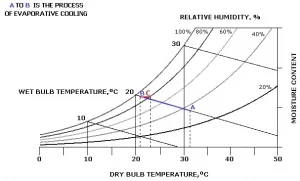Information
Evaporative Cooling
 By forcing water through our specially designed misting nozzles, we create a fog of ultra fine water droplets with an average size of 50 microns or less.
By forcing water through our specially designed misting nozzles, we create a fog of ultra fine water droplets with an average size of 50 microns or less.
These tiny water droplets quickly absorb the energy (heat) present in the environment and evaporate, becoming water vapor (gas). The energy (heat) used to change the water to a gas is eliminated from the environment, hence the air is cooled.
Relative humidity is the amount of moisture in the air compared to the amount of moisture the air could absorb at the same temperature, is a crucial factor in determining cooling potential. The lower the relative humidity, the more water can be vaporized, and the more heat can be removed. Evaporative Cooling can be used effectively in most geographical locations. This is because when temperatures reach their peak during the day, humidity is normally at its lowest point.
Chart For Maximum Potential Drop
 Example: If the temperature is 90 °F ( 32 °C ) with 30% relative humidity and a maximum temperature drop of 25 °F, therefore using the High Efficiency Portable Cooler the temperature could drop to 65 °F ( 18 °C ) (subtract the Catalog termperature of 90 degrees F from the maximum temperature drop of 25 degrees F).
Example: If the temperature is 90 °F ( 32 °C ) with 30% relative humidity and a maximum temperature drop of 25 °F, therefore using the High Efficiency Portable Cooler the temperature could drop to 65 °F ( 18 °C ) (subtract the Catalog termperature of 90 degrees F from the maximum temperature drop of 25 degrees F).
Comparison to phase-change (standard) air conditioning
Less expensive to install
Estimated cost for installation is 1/8 to 1/2 that of refrigerated air conditioning
Less expensive to operate
Estimated cost of operation is 1/4 that of refrigerated air. Power consumption is limited to the fan and water pump vs. compressors, pumps, and blowers.
Fresh air
The constant stream of air from intake to vent through the building freshens the air in the building.
Mounting layout example
The system cools the inhabitants without creating a wet environment.
